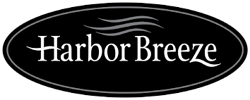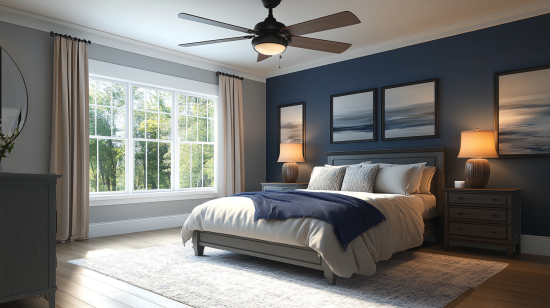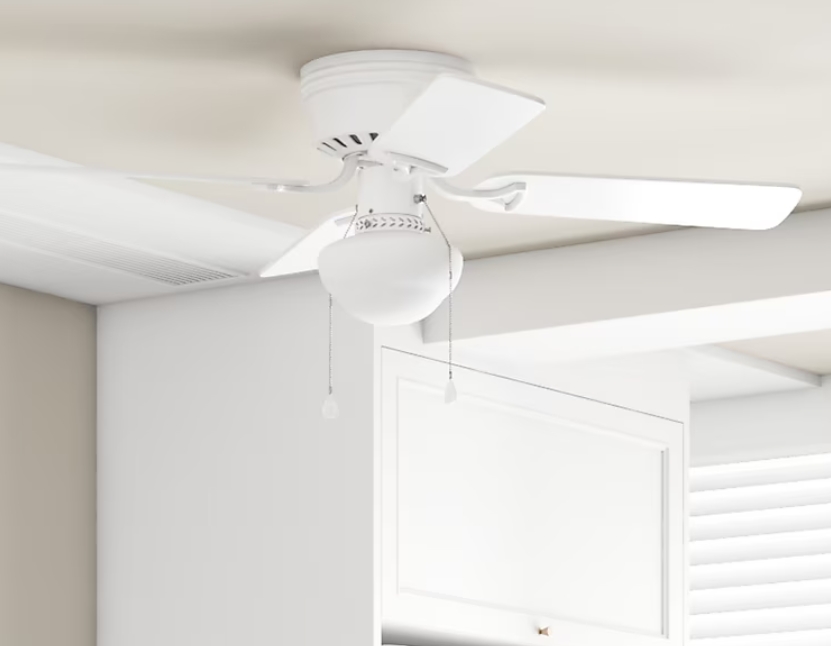
Harbor Breeze Armitage 42-Inches White with White/blonde Blades Indoor Flush mount Standard Ceiling Fan With Light ( 4 -Blade)
- Low profile design to be mounted flush with the ceiling where more walk-through space is
- Easy to use pull chains are included for quick adjustments to the 3 speed settings and on/off light control
- Opal glass globe houses dimmable A15, E26 6.5W LED bulb (included)
- White finish complements the 4 reversible white or blonde ceiling fan blades
- 42-in fan provides airflow ideal for small sized rooms up to 100-sq ft
- Reversible motor efficiently circulates cool air in the summer and warm air in the winter, cutting down on energy costs
- Classic design transcends many styles of decor
- Limited lifetime warranty
$49.48
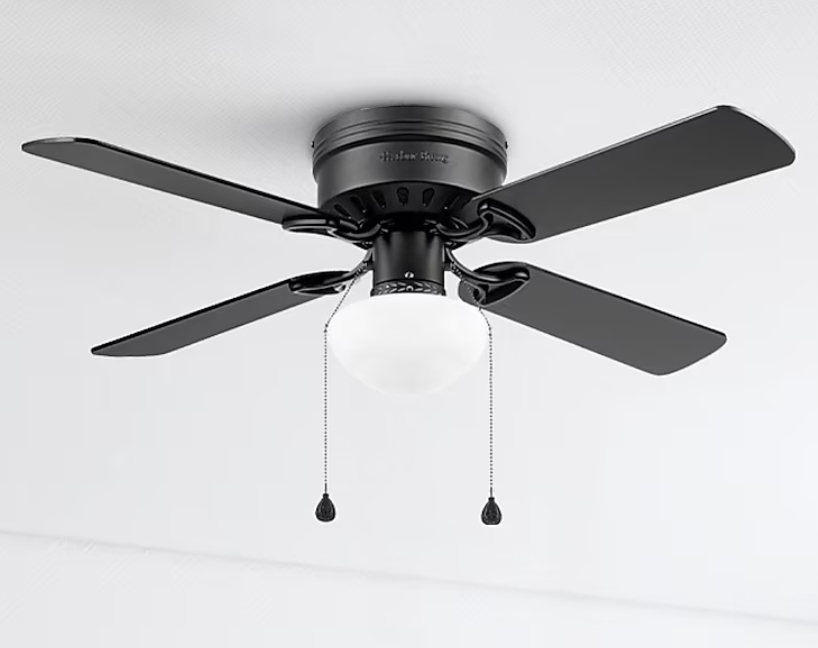
Harbor Breeze Armitage 42-Inches Matte Black with Black/Cocoa Blades Indoor Flush mount Standard Ceiling Fan With Light ( 4 -Blade)
- Low profile design to be mounted flush with the ceiling where more walk-through space is needed
- Easy to use pull chains are included for quick adjustments to the 3 speed settings and on/off light control
- Opal glass globe houses dimmable A15, E26 6.5W LED bulb (included)
- Matte black finish complements the 5 reversible black or cocoa ceiling fan blades
- 42-in fan provides airflow ideal for small sized rooms up to 100-sq ft
- Reversible motor efficiently circulates cool air in the summer and warm air in the winter, cutting down on energy costs
- Classic design transcends many styles of decor
- Limited lifetime warranty
$49.98
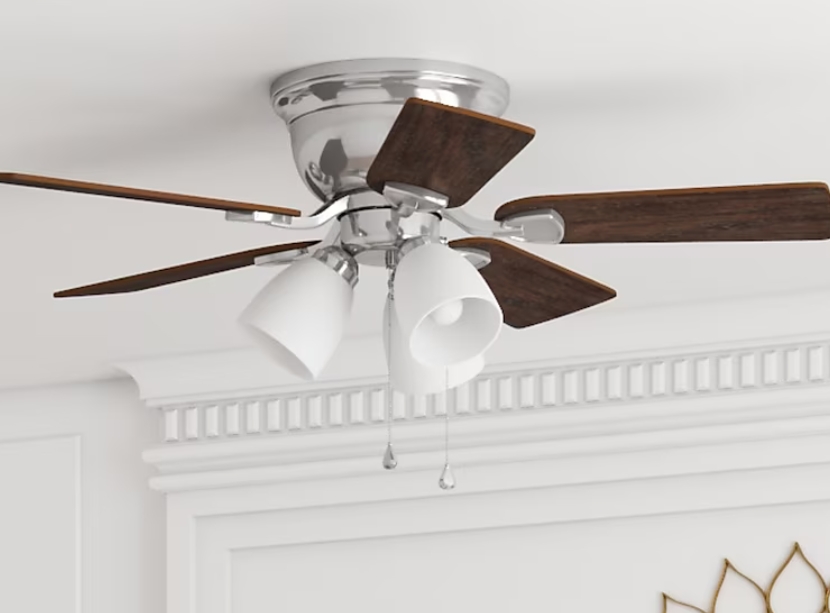
Harbor Breeze Centreville 42-Inches Brushed Nickel with Nutmeg/cocoa Blades Indoor Flush mount Standard Ceiling Fan With Light ( 5 -Blade)
- Low profile design to be mounted flush with the ceiling where more walk-through space is
- Easy to use pull chains are included for quick adjustments to the speed settings and light output
- 3 Arm light kit with marbleized glass includes 3 A15, E26 6.5W LED bulbs
- Brushed nickel finish complements the 5 reversible nutmeg or cocoa ceiling fan blades
- 42-in fan provides airflow up to 2687 CFM, making it ideal for small sized rooms up to 100-sq ft
- Reversible motor efficiently circulates cool air in the summer and warm air in the winter, cutting down on energy costs
- Great for transitional style decor
- Limited lifetime warranty
$82.98
Cooling Comfort Without Breaking the Bank: My Journey With Mid-Sized Ceiling Fans
Last summer changed everything for me. After enduring three months of sweltering heat in my newly purchased bungalow, I finally decided enough was enough. My loyal but ancient box fan wasn’t cutting it anymore, and my energy bills were skyrocketing from running the AC non-stop. That’s when I began my deep dive into the world of ceiling fans—specifically, the Harbor Breeze 42 inch models that kept appearing in my research.
What started as a simple purchase decision turned into a fascinating exploration of airflow physics, home aesthetics, and practical installation challenges. After countless hours of research, several store visits, and conversations with both professional installers and everyday users, I’ve compiled everything I’ve learned about these versatile cooling solutions.
Whether you’re looking to cool a bedroom, home office, or small living space, join me as I share the comprehensive guide I wish I’d had when I started this journey.
What Exactly Is the Harbor Breeze 42 Inch Ceiling Fan?
Before diving into the nitty-gritty details, let’s establish what we’re talking about. Harbor Breeze is a private label brand sold exclusively at Lowe’s home improvement stores. Their 42-inch ceiling fans represent their mid-sized offerings, sitting comfortably between compact 36-inch models and larger 52-inch fans.
I initially assumed all ceiling fans were basically the same, just with different decorative covers. How wrong I was! The 42-inch size is specifically engineered to provide optimal airflow for rooms between 100-225 square feet, making them perfect for average bedrooms, home offices, and smaller living spaces.
These fans aren’t just scaled-down versions of larger models—they’re designed with specific blade pitches and motor strengths to efficiently move air in more confined spaces. This size strikes the perfect balance between performance and proportion, ensuring the fan doesn’t overwhelm smaller rooms visually or create uncomfortable downdrafts in spaces with standard 8-foot ceilings.
The Cost Factor: What You’ll Need to Budget
Let’s talk money—after all, that was one of my primary concerns when shopping. Harbor Breeze 42-inch ceiling fans typically range from $69 to $249, depending on the specific model, features, and finishes.
Basic models with simple designs and pull-chain operation hover around the $70-$100 mark. These are perfectly functional options if you’re on a tight budget or outfitting a rarely-used guest room.
Mid-range models ($100-$175) typically include integrated light fixtures, more attractive finishes, and potentially remote controls. This is where I found the sweet spot in terms of value—enough features to be convenient without unnecessary bells and whistles.
Premium options ($175-$249) offer enhanced aesthetics, higher-quality materials, smart home compatibility, and more powerful motors. If you’re particular about design or plan to use the fan heavily, these might be worth the investment.
I ultimately chose a mid-range model at $139, which included a dimmable LED light kit and remote control. After six months of daily use, I can confirm it was money well spent. The energy savings alone have nearly offset the purchase price compared to my previous cooling methods.
Where to Find Your Perfect Harbor Breeze Fan
As mentioned earlier, Harbor Breeze is Lowe’s exclusive house brand, so you’ll find these fans primarily at Lowe’s retail locations or on their website. During my search, I discovered several advantages to shopping in-store versus online.
In-store shopping allowed me to:
- Examine the build quality firsthand
- See how the various finishes look under different lighting
- Check the noise level of display models
- Ask store associates specific questions about installation
- Take advantage of in-store promotions not available online
That said, shopping online offered:
- The complete catalog of options (stores typically display only the most popular models)
- Customer reviews and ratings
- Detailed specifications
- The convenience of home delivery
I ended up visiting my local Lowe’s twice to examine display models, then ordering online when I found a 15% off promotion. Keep in mind that these fans occasionally appear on secondary marketplaces like eBay or Facebook Marketplace, but I’d be cautious about warranty coverage on these unofficial channels.
The Feature Breakdown: What You’re Getting
Harbor Breeze’s 42-inch ceiling fans come with a variety of features depending on the model. Here’s what you should know about the typical offerings:
Most models include 3-5 blades. While more blades might seem better, it’s actually about balance and aesthetics rather than performance. Three-blade models often move air just as effectively as five-blade versions but with different airflow patterns.
Motor speeds typically include three settings: low, medium, and high. The more expensive models provide smoother transitions between speeds rather than dramatically different performance. I’ve found that having these options is essential for seasonal adjustments—high speed for summer heat, low for gentle air circulation during cooler months.
As for mounting options, most Harbor Breeze 42-inch models support both downrod mounting (for standard ceilings) and flush mounting (for lower ceilings). The downrod length included is usually 4-6 inches, which is sufficient for standard 8-9 foot ceilings. If you have higher ceilings, you’ll likely need to purchase an extended downrod separately.
Room Compatibility: Finding the Right Fit
One question that repeatedly came up in my research was whether a 42-inch fan would be adequate for my spaces. After consulting with a contractor friend and examining multiple floor plans, I developed this simple guideline:
- Small rooms (up to 100 sq ft): 36-inch fans are ideal
- Medium rooms (100-225 sq ft): 42-inch fans work perfectly
- Large rooms (225-400 sq ft): Consider 52-inch or larger fans
My primary bedroom is 168 square feet with an 8-foot ceiling, making the 42-inch Harbor Breeze an ideal fit. The fan provides excellent air circulation without dominating the visual space or creating uncomfortable downdrafts that larger fans might produce in this setting.
For reference, standard room sizes where 42-inch fans excel include:
- Average bedrooms (10×12 to 14×16 feet)
- Home offices (10×10 to 12×12 feet)
- Small living rooms
- Breakfast nooks
- Smaller dens or TV rooms
If you’re on the borderline between sizes, I’d recommend sizing up rather than down. A slightly oversized fan running at lower speeds will be more energy-efficient than a smaller fan constantly running at high speed.
Let There Be Light: Integrated Lighting Options
Most Harbor Breeze 42-inch ceiling fans come with integrated light kits, though some basic models are sold without lighting. During my shopping experience, I saw three primary lighting configurations:
- LED integrated fixtures: These modern options feature built-in LED panels that cannot be replaced individually but typically last 50,000+ hours. My chosen model has this type, and I appreciate the even illumination and energy efficiency.
- Bowl-style fixtures: These traditional options use standard bulbs (often candelabra base) under a glass dome. They provide good general lighting but sometimes create more shadows.
- Exposed bulb designs: These decorative options feature visible bulbs and work well with vintage or industrial décor styles.
Most light kits support standard dimming functionality, though you’ll need compatible dimmer switches if controlling the lights from a wall switch. Remote-controlled models typically include dimming capabilities built into the remote.
When choosing, consider both the light output (typically 600-1,800 lumens) and color temperature (usually 2700K-4000K). Warmer lights (lower K values) create cozier atmospheres, while cooler lights (higher K values) work better in task-oriented spaces.
The Installation Journey: What to Expect
Installation was one of my biggest concerns. While I’m reasonably handy, electrical projects always make me nervous. After watching several videos and reading the manual, I decided to tackle it myself—with a friend on standby.
The typical installation process takes 1-2 hours for someone with basic DIY skills. You’ll need:
- Screwdriver (both Phillips and flathead)
- Wire strippers/cutters
- Pliers
- Ladder
- Voltage tester (highly recommended for safety)
- Wire nuts (usually included)
- Patience (definitely not included)
The basic steps involve:
- Turning off power at the breaker box (absolutely essential)
- Removing any existing light fixture
- Installing the mounting bracket to the ceiling box
- Assembling the fan components (downrod, canopy, etc.)
- Hanging the fan motor assembly
- Connecting the wiring (this is where most people get nervous)
- Attaching the blades
- Installing the light kit
- Testing everything
I found the Harbor Breeze instructions to be clear and well-illustrated. The trickiest part was the wiring, but following the color-coded diagram made it manageable. Most models follow standard wiring conventions: black to black (power), white to white (neutral), and green/copper to green/bare (ground).
If you’re uncomfortable with electrical work, professional installation typically costs $75-$150 depending on your location and ceiling height. In retrospect, this might be money well spent if you’re at all uncertain about the process.
Control Options: Pulls, Switches, and Remotes
My old apartment had a ceiling fan with pull chains that I was constantly fumbling for in the dark. One of my priorities was finding a more convenient control method. Harbor Breeze 42-inch models offer several control configurations:
- Pull chains: Basic models rely on physical pull chains for fan speed and light control. Simple but sometimes inconvenient.
- Wall controls: Some models work with wall-mounted controls that replace standard light switches. These range from simple fan-speed dials to sophisticated digital controls.
- Remote controls: Many mid-range and premium models include handheld remote controls. Mine allows me to adjust speed, turn the light on/off, and dim the light from anywhere in the room. Some remotes include timers and sleep functions.
- Smart controls: Higher-end models may offer compatibility with smart home systems, either built-in or through optional modules. These allow for voice control and integration with other smart home devices.
My remote-controlled model has been a game-changer for convenience. Being able to adjust the fan while lying in bed or working at my desk saves me countless trips across the room. If you’re choosing between similar models, I’d strongly recommend prioritizing remote functionality.
Energy Efficiency: The Hidden Value
One of my major motivations for installing a ceiling fan was reducing energy costs. Harbor Breeze 42-inch models typically consume between 50-75 watts on high speed, significantly less than air conditioners (which can use 1,000+ watts).
Most models are ENERGY STAR certified, meaning they meet strict efficiency guidelines set by the EPA. This certification ensures the fans move air efficiently relative to their energy consumption.
The airflow efficiency is measured in CFM/watt (cubic feet per minute of air moved per watt of electricity used). Higher numbers indicate more efficient models. The Harbor Breeze 42-inch fans I researched ranged from 65-85 CFM/watt, which is quite efficient for their size class.
In practical terms, running a Harbor Breeze 42-inch ceiling fan for 12 hours daily costs roughly $2-$3 per month at average electricity rates. Compare this to running a small room air conditioner, which might cost $30-$60 for the same period.
By using my ceiling fan to supplement air conditioning, I’ve been able to set my thermostat 4 degrees higher without sacrificing comfort, resulting in approximately 20% savings on my summer cooling bills.
Airflow Metrics: Understanding CFM
When I first encountered the term “CFM” (cubic feet per minute) in fan specifications, I was confused about what constituted a “good” number. After consulting HVAC professionals, I learned that airflow capacity for 42-inch Harbor Breeze fans typically ranges from 2,500 to 4,500 CFM, depending on the model.
For context, here’s what those numbers mean in practical terms:
- 2,500-3,000 CFM: Suitable for smaller rooms with minimal airflow needs
- 3,000-3,500 CFM: Good performance for average-sized rooms
- 3,500+ CFM: Excellent airflow, suitable for warmer climates
The model I selected produces approximately 3,800 CFM on its highest setting, which creates a noticeable but not overwhelming breeze throughout my medium-sized bedroom. On summer nights, the high setting cools the room remarkably quickly, while the medium setting provides comfortable continuous airflow.
It’s worth noting that higher CFM ratings don’t always translate to better real-world performance. Blade design, pitch, and motor efficiency all contribute to how effectively the fan distributes air throughout the space.
Seasonal Versatility: The Reversible Feature
One feature I hadn’t considered initially was the reversible motor function. Most Harbor Breeze 42-inch fans allow you to change the direction of blade rotation seasonally:
- Counterclockwise rotation (summer mode): Creates a direct downward breeze that produces a cooling wind-chill effect on skin.
- Clockwise rotation (winter mode): Pulls air upward along the walls, gently recirculating warm air that naturally rises to the ceiling without creating a cooling breeze.
This reversibility extends the fan’s utility throughout the year. During winter months, running the fan on low speed in reverse mode has helped distribute the warm air from my heating system more evenly, reducing my heating costs by approximately 5-10%.
On most models, changing the direction requires flipping a small switch on the motor housing while the fan is stopped. Remote-controlled models might allow direction changes via the remote, which is much more convenient.
Installation Flexibility: Working With Your Space
My home has varying ceiling heights and angles, so mounting flexibility was important to me. Harbor Breeze 42-inch fans offer several mounting options to accommodate different ceiling types:
- Standard downrod mounting: Ideal for flat ceilings with heights of 8-9 feet. Most models include a 3-6 inch downrod.
- Flush mounting (also called “hugger” or “low profile”): For ceilings below 8 feet, some models can be installed directly against the ceiling without a downrod.
- Angled ceiling mounting: Most Harbor Breeze models can accommodate sloped ceilings up to 30 degrees with the included mounting hardware. For steeper slopes (up to 45 degrees), an angled ceiling adapter kit is usually available separately.
- Extended downrod mounting: For ceilings taller than 9 feet, you can purchase longer downrods to position the fan at the optimal height (typically 8-9 feet from the floor).
My primary installation was on a standard 8-foot flat ceiling, but I also installed one in a room with a 12-degree slope. The included mounting hardware handled the slope without requiring additional adapters, which was a pleasant surprise.
Material Quality and Construction
The materials used in Harbor Breeze 42-inch fans vary by price point. Understanding these differences helped me make a more informed decision:
- Motors: Entry-level models typically use less powerful motors with fewer copper windings, while premium models feature motors with more copper and better bearings for smoother operation and longer life.
- Blades: Blade materials include:
- Particle board with laminate (basic models)
- MDF with wood veneer (mid-range models)
- Solid wood (premium models)
- ABS plastic (weather-resistant models)
- Hardware: Most models use standard steel hardware with various finishes to match the fan body. Premium models may use corrosion-resistant hardware for longer durability.
- Housing: Fan motor housings are typically made from stamped steel in lower-priced models and die-cast metal in premium options.
I opted for a mid-range model with MDF blades and a die-cast housing, which struck a good balance between durability and cost. After six months of daily use, I’ve noticed no wobbling or noise development, suggesting the construction quality is solid.
Style and Finish Options: Matching Your Décor
One aspect that initially overwhelmed me was the variety of styles and finishes available. Harbor Breeze offers their 42-inch fans in several design families, from traditional to contemporary to transitional.
Popular finishes include:
- Brushed nickel (versatile, works with most décors)
- Oil-rubbed bronze (traditional, works well with darker woods)
- Matte black (contemporary, popular in modern spaces)
- White (clean look, blends with white ceilings)
- Polished chrome (bright, reflective finish for contemporary spaces)
- Wood tones (various stains to match furniture)
Beyond finishes, the blade and light kit designs vary significantly. Some have elaborate decorative elements, while others embrace minimalist aesthetics. The Mazon model, for instance, features a flush mount contemporary design, while the Armitage offers a more traditional profile with decorative housing details.
I ultimately chose a brushed nickel finish with simple lines that would coordinate with both my current décor and potential future changes. When selecting your finish, consider both your existing furnishings and your home’s architectural style for the most harmonious look.
The Noise Factor: How Quiet Is Quiet?
Noise level was a major consideration for me, especially for bedroom installation. Harbor Breeze 42-inch fans vary in their operational sound, which is influenced by:
- Motor quality
- Bearing type
- Blade balance
- Installation quality
In general, more expensive models run quieter due to better components and tighter manufacturing tolerances. Based on my experience and research, here’s what you can expect:
- Budget models ($69-$100): Typically produce a soft but noticeable hum, especially at higher speeds. You’ll be aware of them running but not usually distracted.
- Mid-range models ($100-$175): Generally quiet at low and medium speeds with a soft hum at high speed. My model falls in this category and is virtually silent at low speed, with a gentle white noise at medium that actually helps me sleep.
- Premium models ($175+): Often use DC motors rather than AC, resulting in whisper-quiet operation at all speeds.
If noise sensitivity is a primary concern, I’d recommend visiting a store to hear display models in person or investing in a DC motor model, which typically adds $50-$100 to the price but provides significantly quieter operation.
The Verdict From Real Users
Before making my final decision, I spent hours reading user reviews across multiple platforms. Here’s what I found most Harbor Breeze 42-inch fans receive:
- Average ratings: Typically 4.2-4.6 out of 5 stars
- Positive comments: Frequently mention good value, attractive appearance, and adequate airflow
- Critical comments: Usually focus on installation difficulties, missing parts, or noise development over time
The most frequent praise was for the fans’ appearance and value proposition. Many reviewers mentioned being pleasantly surprised by the quality relative to the price point. Remote-controlled models received particularly positive feedback for their convenience.
The most common complaints centered around quality control issues (missing hardware, unbalanced blades) and difficulty understanding installation instructions. A small percentage of users reported motor failures within 1-2 years, which appears to be more common with the lowest-priced models.
Based on aggregated reviews, the sweet spot seems to be in the $120-$160 range, where the quality improvements justify the price increase over basic models without reaching the diminishing returns of premium options.
The Warranty Question: What’s Covered?
Harbor Breeze typically offers limited lifetime warranties on their ceiling fan motors and one-year warranties on other components. Understanding what this actually means helped me assess the value:
The “limited lifetime” motor warranty generally covers manufacturing defects but not normal wear and tear or improper installation. In practice, this means if the motor fails due to an internal defect, it should be replaceable.
The one-year warranty on other parts covers items like the light kit, remote control, and blades. This shorter coverage period is standard across most ceiling fan brands.
To maintain warranty coverage, you’ll need to:
- Keep your receipt
- Use the fan as intended (indoor fans indoors, etc.)
- Follow proper installation procedures
- Use manufacturer-approved accessories
It’s worth noting that warranty service requires contacting Lowe’s or the manufacturer directly. Some reviewers mentioned challenges with warranty claims, suggesting it’s better to discover any issues early while return options are still available.
Size Comparisons: 42-Inch vs. 52-Inch Models
During my research, I debated between 42-inch and 52-inch models. Here’s how they compare:
42-inch fans are ideal for:
- Rooms between 100-225 square feet
- Lower ceilings (8 feet)
- Bedrooms, offices, and smaller living spaces
- Spaces where a larger fan might look disproportionate
52-inch fans are better suited for:
- Rooms between 225-400 square feet
- Medium to large bedrooms
- Living rooms and family rooms
- Open concept spaces
- Higher ceilings (9+ feet)
Performance-wise, 52-inch models typically move 20-30% more air than comparable 42-inch versions, but they also consume more electricity and create stronger downdrafts. In smaller spaces, these stronger downdrafts can actually be uncomfortable, disturbing papers and creating too much airflow.
From a design perspective, 42-inch fans look more proportional in smaller rooms and don’t visually dominate the ceiling the way larger models might. If you’re uncertain, measuring your room and using the square footage guidelines above is the safest approach.
Indoor vs. Outdoor Considerations
Most Harbor Breeze 42-inch fans are designed exclusively for indoor use. However, they do offer specific models rated for damp locations (covered porches, bathrooms) or wet locations (exposed outdoor areas).
Standard indoor models should never be installed outdoors as moisture can damage the motor and electrical components, creating both performance issues and safety hazards.
If you’re looking for an outdoor fan, specifically seek models labeled as:
- Damp rated: Suitable for covered outdoor areas like porches where the fan won’t be directly exposed to rain
- Wet rated: Designed for full outdoor exposure, featuring sealed motors and weather-resistant materials
Outdoor-rated fans typically cost 15-30% more than comparable indoor models due to the additional weatherproofing features. They also tend to have simpler designs with fewer decorative elements that might trap moisture.
Finding the Best Deal: Sales and Promotions
During my six-month research period, I noticed several patterns in Harbor Breeze pricing and promotions:
- Seasonal sales: The best discounts typically appear in early spring (April-May) and fall (September-October), when retailers are transitioning between cooling and heating seasons.
- Holiday promotions: Memorial Day, Labor Day, and Black Friday typically feature significant ceiling fan discounts, often 15-25% off regular prices.
- Clearance opportunities: As new models are introduced, older designs are frequently clearanced at 30-50% off. These can be exceptional values if you’re not particular about having the latest style.
- Bundle deals: Some retailers offer discounted installation services or free extended downrods when purchasing ceiling fans at full price.
I ultimately purchased during a Memorial Day sale, saving about $30 off the regular price. Had I been more patient, I might have found a better deal during end-of-season clearance, but the immediate comfort was worth the slightly higher cost.
Making Your Final Decision: My Personal Framework
After all this research and my own experience, I developed a simple framework for choosing the right Harbor Breeze 42-inch ceiling fan:
- Measure your room to confirm a 42-inch fan is appropriate
- Determine your budget range
- List must-have features (light kit, remote, specific finish)
- Consider your ceiling height and angle for mounting requirements
- Evaluate your noise tolerance and prioritize accordingly
- Decide on style preferences that match your décor
Using this approach narrowed my choices from dozens to just three models, making the final decision much simpler. I eventually selected the model that offered the best balance of features, aesthetics, and value rather than maximizing any single factor.
My Six-Month Verdict: Was It Worth It?
After living with my Harbor Breeze 42-inch ceiling fan for over six months through both summer heat and winter chill, I can confidently say it was a worthwhile investment.
The most immediate benefit was improved comfort during hot weather. The fan created enough airflow to make my bedroom feel 3-5 degrees cooler without running the air conditioner, saving me approximately $35-$45 monthly on summer energy bills.
During winter, reversing the blade direction helped distribute warm air more evenly, reducing cold spots and improving overall comfort. This allowed me to lower my thermostat setting by 1-2 degrees without feeling colder.
From an aesthetic perspective, the fan added a finished look to my bedroom ceiling that the previous basic light fixture lacked. Several guests have commented positively on its appearance, suggesting it enhanced rather than detracted from the room’s design.
The convenience factor exceeded my expectations. The remote control functionality eliminated the nightly hunt for pull chains in the dark, and being able to adjust fan speed from bed has improved my sleep quality during changing weather conditions.
Most importantly, the fan has operated flawlessly since installation, with no development of wobble, noise, or electrical issues. For a product in the mid-price range, this reliability has been reassuring.
Final Thoughts: The Cooling Solution You Didn’t Know You Needed
When I began researching ceiling fans, I viewed them primarily as functional devices—practical but hardly exciting. Six months later, I’ve become something of a ceiling fan evangelist, recommending them to friends and family members looking to improve comfort while reducing energy costs.
The Harbor Breeze 42-inch fan struck the perfect balance for my medium-sized spaces, providing efficient cooling without overwhelming the room visually or sonically. While there are certainly cheaper and more expensive options on the market, the Harbor Breeze line offers solid performance at reasonable price points with sufficient variety to match most décor styles.
If you’re on the fence about adding a ceiling fan to your home, I’d encourage you to take the plunge—particularly if you’re currently relying solely on air conditioning for cooling or experiencing uneven temperatures throughout your space. The combination of energy savings, improved comfort, and enhanced room aesthetics makes it one of the most worthwhile home improvements I’ve made in recent years.
Whatever model you choose, I hope this guide has helped demystify some of the technical aspects and practical considerations involved in selecting the right ceiling fan for your needs. Stay cool, friends!
